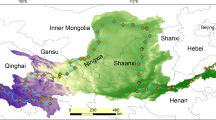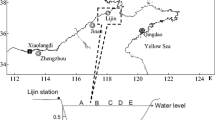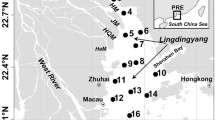Abstract
Phosphorus (P) is potentially the most limiting nutrient in the Pearl River estuary, and thus, it is important to understand various sources of P. Suspended particulate matter (SPM) is usually high in the river and carries P. We hypothesize that suspended particulate reactive P (PRP) is a potential source of dissolved P and varies with estuarine hydrodynamics. To test the hypothesis, we conducted a cruise along and cross the Pearl River estuary to examine spatial variability of suspended PRP. Suspended PRP ranged at 0.01–2.65 μM, contributing 1.2–97.4% to total reactive P (TRP). Along the estuary, suspended PRP was 1.49 μM upstream and decreased downstream. Across the estuary, suspended PRP was high (1.58 μM) at low salinity and decreased eastward with increasing salinity. Tidal cycles appeared to play a significant role in regulating the variability of suspended PRP through advection and benthic resuspension of SPM. The proportion of PRP/TRP increased seaward from 1.2 to 94.8%, indicating the increasing importance of PRP in total reactive P downstream. We show that suspended particulate reactive P varied greatly and was an important part of the total phosphorus pool in the Pearl River estuary.









Similar content being viewed by others
References
Benitez-Nelson, C.R. 2000. The biogeochemical cycling of phosphorus in marine systems. Earth-Science Reviews 51 (1–4): 109–135.
Bowe, M.J., H.P. Jarvie, S.J. Halliday, R.A. Skeffington, A.J. Wade, M. Loewenthal, E. Gozzard, J.R. Newman, and E.J. Palmer-Felgate. 2015. Characterising phosphorus and nitrate inputs to a rural river using high-frequency concentration-flow relationships. Science of the Total Environment 511: 608–620.
Brook, E.J., and J.N. Moore. 1988. Particle-size and chemical control of as, cd, cu, Fe, Mn, Ni, Pb, and Zn in bed sediment from the Clark Fork River, Montana (U.S.a.). Science of the Total Environment 76: 247–266.
Cheung, K.C., B.H.T. Poon, C.Y. Lan, and M.H. Wong. 2003. Assessment of metal and nutrient concentrations in river water and sediment collected from the cities in the Pearl River Delta, South China. Chemosphere 52 (9): 1431–1440.
Cui, Y.S., J.X. Wu, J. Ren, and J. Xu. 2019. Physical dynamics structures and oxygen budget of summer hypoxia in the Pearl River estuary. Limnology and Oceanography 64 (1): 131–148.
Deborde, J., P. Anschutz, G. Chaillou, H. Etcheber, M.V. Commarieu, P. Lecroart, and G. Abril. 2007. The dynamics of phosphorus in turbid estuarine systems: Example of the gironde estuary (France). Limnology and Oceanography 52 (2): 862–872.
DePinto, J.V., T.C. Young, and S.C. Martin. 1981. Algal-available phosphorus in suspended sediments from lower Great Lakes tributaries. Journal of Great Lakes Research 7 (3): 311–325.
Dong, L.X., J.L. Su, L.A. Wong, Z.Y. Cao, and J.C. Chen. 2004. Seasonal variation and dynamics of the Pearl River plume. Continental Shelf Research 24 (16): 1761–1777.
Dong, L.X., J.L. Su, Y. Li, X.M. Xia, and W.B. Guan. 2006. Physical processes and sediment dynamics in the Pearl River. In The environment in Asia Pacific Harbours, ed. E. Wolanski, 127–137. Netherlands: Springer.
Dorich, R.A., D.W. Nelson, and L.E. Sommers. 1985. Estimating algal available phosphorus in suspended sediments by chemical extraction. Journal of Environmental Quality 14: 400–405.
Fabre, A., A. Qotbi, A. Dauta, and V. Baldy. 1996. Relation between algal available phosphate in the sediments of the river Garonne and chemically-determined phosphate fractions. Hydrobiologia 335: 43–48.
Föllmi, K.B. 1996. The phosphorus cycle, phosphogenesis and marine phosphate-rich deposits. Earth-Science Review 40 (1–2): 55–124.
Fujiki, T., T. Toda, T. Kikuchi, H. Aono, and S. Taguchi. 2004. Phosphorus limitation of primary productivity during the spring-summer blooms in Sagami Bay, Japan. Marine Ecology Progress Series 283: 29–38.
Golterman, H.L. 1976. Sediments as a source of phosphate for algal growth. In Interactions between sediments and freshwater, ed. H.L. Golterman, 286–293. Netherlands: Proceedings of an international symposium held in Amsterdam.
Grasshoff, K.M., K. Kremling, and M. Ehrhardt. 1999. Methods of seawater analysis, third Edition. Weinheim: Wiley-VCH Verlag.
Guo, Q., K. Shi, C.F. Xu, and L.M. Hou. 2019. Determination of the total phosphorus in turbid solution by corrected spectrophotometry. Journal of Guangxi University 44 (5): 1379–1383 (in Chinese with English abstract).
Han, A.Q., M.H. Dai, S.J. Kao, J.P. Gan, Q. Li, L.F. Wang, W.D. Zhai, and L. Wang. 2012. Nutrient dynamics and biological consumption in a large continental shelf system under the influence of both a river plume and coastal upwelling. Limnology and Oceanography 57 (2): 486–502.
Harrison, P.J., K.D. Yin, J.H.W. Lee, J.P. Gan, and H.B. Liu. 2008. Physical–biological coupling in the Pearl River estuary. Continental Shelf Research 28 (12): 1405–1415.
He, H.J., H.T. Chen, Q.Z. Yao, Y.W. Qin, T.Z. Mi, and Z.G. Yu. 2009. Behavior of different phosphorus species in suspended particulate matter in the Changjiang estuary. Chinese Journal of Oceanology and Limnology 27 (4): 859–868.
Horowitz, A.J. 1991. A primer on sediment-trace element chemistry. second ed. Lewis Publishers Inc..
Hyacinthe, C., S. Bonneville, and P. Van Cappellen. 2006. Reactive iron (III) in sediments: Chemical versus microbial extractions. Geochimica et Cosmochimica Acta 70: 4166–4180.
Jia, H.L., M.R. Chen, W. Su, S.L. Zhang, and K. Zhao. 2019. Structural characteristics and associated factors influencing phytoplankton abundance and species composition in Huangmaohai Bay, Pearl River estuary. Journal of Coastal Research 35 (1): 72–81.
Jiang, Z.Y., Y.S. Wang, H. Cheng, C.C. Sun, and M.L. Wu. 2015. Variation of phytoplankton community structure from the Pearl River estuary to South China Sea. Ecotoxicology 24 (7–8): 1442–1449.
Jordan, T.E., J.C. Cornwell, W.R. Boynton, and J.T. Anderson. 2008. Changes in phosphorus biogeochemistry along an estuarine salinity gradient: The iron conveyer belt. Limnology and Oceanography 53 (1): 172–184.
Leong, D.N.S., S.D. Donner, M.A. Hassan, R. Gabor, and J.D. Drummond. 2014. Sensitivity of stoichiometric ratios in the Mississippi River to hydrologic variability. Journal of Geophysical Research: Biogeosciences 119 (6): 1049–1062.
Li, J., P.M. Glibert, M. Zhou, S. Lu, and D. Lu. 2009. Relationships between nitrogen and phosphorus forms and ratios and the development of dinoflagellate blooms in the East China Sea. Marine Ecology Progress Series 383: 11–26.
Li, R.H., J. Xu, X.F. Li, Z. Shi, and P.J. Harrison. 2017. Spatiotemporal variability in phosphorus species in the Pearl River estuary: Influence of the river discharge. Scientific Reports 7 (1).
Lin, P., J.V. Klump, and L. Guo. 2016. Dynamics of dissolved and particulate phosphorus influenced by seasonal hypoxia in Green Bay, Lake Michigan. Science of the Total Environment 541: 1070–1082.
Liu, S.M., X.H. Qi, X. Li, H.R. Ye, Y. Wu, J.L. Ren, J. Zhang, and W.Y. Xu. 2016. Nutrient dynamics from the Changjiang (Yangtze River) estuary to the East China Sea. Journal of Marine Systems 154 (Part A): 15–27.
Logan, T.J., T.O. Oloya, and S.M. Yaksich. 1979. Phosphate characteristics and bioavailability of suspended sediments from streams draining into Lake Erie. Journal of Great Lakes Research 5: 112–123.
Luo, L., S. Li, and D. Wang. 2009. Hypoxia in the Pearl River estuary, the South China Sea, in July 1999. Aquatic Ecosystem Health & Management 12 (4): 418–428.
Mao, Q.W., P. Shi, K.D. Yin, J.P. Gan, and Y.Q. Qi. 2004. Tides and tidal currents in the Pearl River estuary. Continental Shelf Research 24 (16): 1797–1808.
Mayer, L.M., and S.P. Gloss. 1980. Buffering of silica and phosphate in a turbid river. Limnology and Oceanography 25 (1): 12–22.
Meng, J., Q. Yao, and Z. Yu. 2014. Particulate phosphorus speciation and phosphate adsorption characteristics associated with sediment grain size. Ecological Engineering 70: 140–145.
Meng, J., Z.G. Yu, Q.Z. Yao, T.S. Bianchi, A. Paytan, B. Zhao, H.H. Pan, and P. Yao. 2015. Distribution, mixing behavior, and transformation of dissolved inorganic phosphorus and suspended particulate phosphorus along a salinity gradient in the changjiang estuary. Marine Chemistry 168: 124–134.
Meybeck, M. 1993. C, N, P and S in rivers: From sources to global inputs. In: Interactions of C, N, P and S biogeochemical cycles and global change (pp. 163-193). Springer, Berlin, Heidelberg.
Milliman, J.D., H.T. Shen, Z.S. Yang, and R.H. Meade. 1985. Transport and deposition of river sediment in the Changjiang estuary and adjacent continental shelf. Continental Shelf Research 4 (1–2): 37–45.
Murrell, M.C., R.S. Stanley, E.M. Lores, G.T. DiDonato, L.M. Smith, and D.A. Flemer. 2002. Evidence that phosphorus limits phytoplankton growth in a Gulf of Mexico estuary: Pensacola bay, Florida, USA. Bulletin of Marine Science 70 (1): 155–167.
Pacini, N., and R. Gächter. 1999. Speciation of riverine particulate phosphorus during rain events. Biogeochemistry 47 (1): 87–109.
Paerl, H.W., and D. Justić. 2011. Primary producers: Phytoplankton ecology and trophic dynamics in coastal waters. In: Wolansky, E., McLusky, D.S. (Eds.), treatise on estuarine and coastal science, vol. 6. (pp. 23–42), academic press, Waltham.
Pan, G., M.D. Krom, and B. Herut. 2002. Adsorption-desorption of phosphate on airborne dust and riverborne particulates in East Mediterranean seawater. Environmental Science & Technology 36 (16): 3519–3524.
Pastuszak, M., K. Nagel, A. Grelowski, V. Mohrholz, and M. Zalewski. 2003. Nutrient dynamics in the Pomeranian Bay (southern Baltic): Impact of the Oder River outflow. Estuaries 26 (5): 1238–1254.
Prastka, K.E., and S.J. Malcolm. 1994. Particulate phosphorus in the Humber estuary. Aquatic Ecology 28: 397–403.
Roy, E.D., J.R. White, E.A. Smith, S. Bargu, and C. Li. 2013. Estuarine ecosystem response to three large-scale Mississippi River flood diversion events. Science of the Total Environment 458: 374–387.
Ruban, V., J.F. Lopez-Sanchez, P. Pardo, G. Rauret, H. Muntau, and P. Quevauviller. 1999. Selection and evaluation of sequential extraction procedures for the determination of phosphorus forms in lake sediment. Journal of Environmental Monitoring 1 (1): 51–56.
Ruttenberg, K.C. 1992. Development of a sequential extraction method for different forms of phosphorus in marine sediments. Limnology and Oceanography 37: 1460–1482.
Ruttenberg, K.C. 2003. The global phosphorus cycle. Treatise on Geochemistry 8: 682.
Sylvan, J.B., Q. Dortch, D.M. Nelson, A.F. Maier Brown, W. Morrison, and J.W. Ammerman. 2006. Phosphorus limits phytoplankton growth on the Louisiana shelf during the period of hypoxia formation. Environmental Science and Technology 40 (24): 7548–7553.
Tang, X.Q., X. Wu, X.C. Dai, and P.H. Chai. 2014. Phosphorus storage dynamics and adsorption characteristics for sediment from a drinking water source reservoir and its relation with sediment compositions. Ecological Engineering 64: 276–284.
Vink, S., R.M. Chambers, and S.V. Smith. 1997. Distribution of phosphorus in sediments from Tomales Bay, California. Marine Geology 139 (1–4): 157–179.
Wang, Q.R., and Y.C. Li. 2010. Phosphorus adsorption and desorption behavior on sediments of different origins. Journal of Soils and Sediments 10 (6): 1159–1173.
Wang, W.L., J.F. Chen, H.Y. Jin, J.D. Liu, M.M. Jin, Y. Lu, B. Xue, H.L. Li, and K. Wang. 2009. The distribution characteristics and influence factors of some species phosphorus in waters of the Changjiang River estuary in summer. Journal of Marine Sciences 27: 32–41 (in Chinese with English abstract).
Westheimer, F.H. 1987. Why nature chose phosphates. Science 235: 1173–1178.
Wildung, R.E., and R.L. Schmidt. 1973. Phosphorus release from Lake sediments. Washington: U.S. Environmental Protection Agency.
Williams, J.D.H., H. Shear, and R.L. Thomas. 1980. Availability to Scenedesmus quadricauda of different forms of phosphorus in sedimentary materials of the Great Lakes. Limnology and Oceanography 25: 1–11.
Wong, L.A., J.C. Chen, H.L. Xue, X. Dong, J.L. Su, and G. Heinke. 2003. Amodel study of the circulation for the Pearl River estuary (PRE) and its adjacent coastalwaters:1. Simulations and comparisons with observations. Journal of Geophysical Research Atmospheres 108 (5): 3156–3164.
Wu, G., W. Cao, Z. Huang, C.M. Kao, C.T. Chang, P.C. Chiang, and F. Wang. 2017. Decadal changes in nutrient fluxes and environmental effects in the Jiulong River estuary. Marine Pollution Bulletin 124 (2): 871–877.
Xiao, Y., H.K. Cheng, X.L. Zhu, and H.W. Tang. 2015. Experimental study on adsorption of phosphorus on sediment components with different particle sizes. Environmental Engineering and Management Journal 14 (10): 2493–2499.
Xu, J., K.D. Yin, L. He, X.C. Yuan, A.Y.T. Ho, and P.J. Harrison. 2008. Phosphorus limitation in the northern South China Sea during late summer: Influence of the Pearl River. Deep Sea Research Part I: Oceanographic Research Papers 55 (10): 1330–1342.
Xu, H., E. Wolanski, and Z.Y. Chen. 2013. Suspended particulate matter affects the nutrient budget of turbid estuaries: Modification of the LOICZ model and application to the Yangtze estuary. Estuarine Coastal and Shelf Science 127: 59–62.
Yao, Q.Z., J.T. Du, H.T. Chen, and Z.G. Yu. 2016. Particle-size distribution and phosphorus forms as a function of hydrological forcing in the Yellow River. Environmental Science and Pollution Research 23 (4): 3385–3398.
Yin, K.D., and P.J. Harrison. 2000. Influences of flood and ebb tides on nutrient fluxes and chlorophyll on an intertidal flat. Marine Ecology Progress Series 196: 75–85.
Yin, K.D., and P.J. Harrison. 2008. Nitrogen over enrichment in subtropical Pearl River estuarine coastal waters: Possible causes and consequences. Continental Shelf Research 28 (12): 1435–1442.
Yin, K.D., P.Y. Qian, J.C. Chen, D.P.H. Hsieh, and P.J. Harrison. 2000. Dynamics of nutrients and phytoplankton biomass in the Pearl River estuary and adjacent waters of Hong Kong during summer: Preliminary evidence for phosphorus and silicon limitation. Marine Ecology Progress Series 194: 295–305.
Yin, K.D., X.X. Song, J. Sun, and M.C.S. Wu. 2004a. Potential P limitation leads to excess N in the Pearl River estuarine coastal plume. Continental Shelf Research 24 (16): 1895–1907.
Yin, K.D., Z.F. Lin, and Z.Y. Ke. 2004b. Temporal and spatial distribution of dissolved oxygen in the Pearl River estuary and adjacent coastal waters. Continental Shelf Research 24 (16): 1935–1948.
Yin, K.D., J.L. Zhang, P.Y. Qian, W.J. Jian, L.M. Huang, J.F. Chen, and M.C.S. Wu. 2004c. Effect of wind events on phytoplankton blooms in the Pearl River estuary during summer. Continental Shelf Research 24 (16): 1909–1923.
Yin, K.D., P.J. Harrison, M. Broom, and C.H. Chung. 2011. Ratio of nitrogen to phosphorus in the Pearl River and effects on the estuarine coastal waters: Nutrient management strategy in Hong Kong. Physics and Chemistry of the Earth 36 (9–11): 411–419.
Yin, K.D., P.Y. Qian, M.C. Wu, J.C. Chen, L. Huang, X. Song, and W. Jian. 2001. Shift from P to N limitation of phytoplankton growth across the Pearl River estuarine plume during summer. Marine Ecology Progress Series 221: 17–28.
Yu, Y., J.M. Song, X.G. Li, H.M. Yuan, and N. Li. 2012. Distribution, sources and budgets of particulate phosphorus and nitrogen in the East China Sea. Continental Shelf Research 43: 142–155.
Yuan, H., J. Song, J. Xing, X. Li, N. Li, L. Duan, B.X. Qu, and Q. Wang. 2018. Spatial and seasonal variations, partitioning and fluxes of dissolved and particulate nutrients in Jiaozhou Bay. Continental Shelf Research 171: 140–149.
Zhang, J. 1999. Nutrient elements in large Chinese estuaries. Continental Shelf Research 16 (8): 1023–1045.
Zhang, J. 2002. Biogeochemistry of Chinese estuarine and coastal waters: Nutrients, trace metals and biomarkers. Regional Environmental Change 3 (1–3): 65–76.
Zhang, S.R., X.X. Lu, D.L. Higgitt, C.T.A. Chen, J.T. Han, and J.G. Sun. 2008. Recent changes of water discharge and sediment load in the Zhujiang (Pearl River) basin, China. Global and Planetary Change 60 (3–4): 365–380.
Zhang, W., X.Y. Wei, J.H. Zheng, Y.L. Zhu, and Y.J. Zhang. 2012. Estimating suspended sediment loads in the Pearl River Delta region using sediment rating curves. Continental Shelf Research 38: 35–46.
Zhang, L., Z. Shi, J.P. Zhang, Z.J. Jiang, L.M. Huang, and Z.P. Huang. 2016. Characteristics of nutrients and phytoplankton productivity in Guangdong coastal regions, South China. Marine Pollution Bulletin 113 (1–2): 572–578.
Zhao, H. 1990. The evolution of the Pearl River estuary, 1–357. Beijing: China Ocean Press (in Chinese).
Zou, L., J. Zhang, W.X. Pan, and Y.P. Zhan. 2001. In situ nutrient enrichment experiment in the Bohai and Yellow Sea. Journal of Plankton Research 23 (10): 1111–1119.
Zuo, J.L., J.M. Song, H.M. Yuan, X.G. Li, N. Li, and L.Q. Duan. 2016. Particulate nitrogen and phosphorus in the East China Sea and its adjacent Kuroshio waters and evaluation of budgets for the East China Sea shelf. Continental Shelf Research 131: 1–11.
Funding
This study was supported by grants from the Guangdong-NSF China Joint Scheme Key Project (U1701247) and the NSF China (No.91328203) and the NMENC-SYSU contract *#201819 and the NNSF China (No. 41406133).
Author information
Authors and Affiliations
Corresponding author
Additional information
Communicated by Hongbin Liu
Supplementary information
ESM 1
(DOCX 22 kb)
Rights and permissions
About this article
Cite this article
Lan, F., Zhang, Y., He, L. et al. Effects of Suspended Particulate Reactive Phosphorus on Phosphorus Cycle in the Pearl River Estuary. Estuaries and Coasts 44, 1310–1319 (2021). https://doi.org/10.1007/s12237-020-00863-5
Received:
Revised:
Accepted:
Published:
Issue Date:
DOI: https://doi.org/10.1007/s12237-020-00863-5




